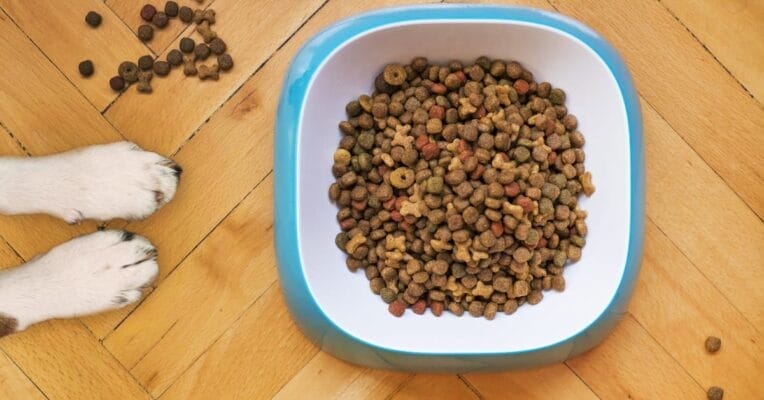How Many Calories In A Cup Of Dog Food

Introduction:
All guide about “How Many Calories In A Cup Of Dog Food” Our four-legged companions bring joy, laughter, and unconditional love into our lives, and as responsible pet owners, we strive to provide them with the best care possible. One crucial aspect of canine well-being is a balanced and nutritious diet. But have you ever wondered about the calorie content in a cup of dog food ?
The Importance of a Balanced Diet for Dogs:
Before delving into the calorie count of “Dog food”, it’s crucial to emphasize the significance of a well-balanced diet for our canine companions. Dogs, like humans, require a mix of proteins, fats, carbohydrates, vitamins, and minerals to thrive. A balanced diet supports theiy levels, promotes healthy growth, and boosts their immune system.
Caloric Needs of Dogs:
The number of calories a dog needs depends ding their size, age, breed, activity level, and overall health. Puppies, for example, have higher energy requirements for growth and development than senior dogs. Similarly, an active breed such as a Border Collie will need more calories than a sedentary breed like a Bulldog.
Understanding Dog Food Labels:
To determine the caloric content of your dog food, it’s essential to read and comprehend the information provided on the packaging. Dog food labels typically display the caloric content per cup or per serving. Keep in mind that different brands and formulations may vary in calorie density, so it’s crucial to follow the feeding guidelines provided by the manufacturer.
Calories in Dry Dog Food?
On average, a cup of dry dog food contains approximately 300 to 500 calories. However, this can vary widely depending on the brand, recipe, and the factors mentioned earlier. It’s essential to choose a dog food that aligns with your pet’s specific needs, considering factors such as age, size, and activity level.
HOW MANY CALORIES SHOULD MY DOG HAVE DAILY?
Ensuring your dog maintains a healthy weight is vital for their overall well-being, and understanding their daily caloric needs is a key aspect of responsible pet ownership. HOW MANY CALORIES SHOULD MY DOG HAVE DAILY? The number of calories your dog requires depends on several factors, including their size, age, breed, and activity level. Generally, a healthy dog needs around 25 to 30 calories per pound of body weight per day, but this can vary.
Puppies and highly active breeds may require more, while senior dogs or those with lower activity levels may need fewer calories. To determine the precise daily caloric intake for your furry friend, consult your veterinarian. They can assess your dog’s specific needs based on factors like metabolism, health condition, and lifestyle, ensuring that you provide the right amount of nutrition to keep your canine companion happy and healthy.

What’s Dog’s Maintenance Energy
“How Many Calories In A Cup Of Dog Food“
Just like us, our canine companions have unique nutritional needs, and understanding their maintenance calories is key to keeping them healthy and happy. Maintenance calories refer to the number of calories a dog needs to sustain their current weight and energy level. This figure is influenced by various factors, including the dog’s size, age, breed, and activity level.
Factors Influencing “Dog Food” Maintenance Calories:
- Size: Larger dogs generally require more calories than smaller ones due to their higher metabolic rates and energy needs.
- Age: Puppies and younger dogs often have higher maintenance calorie requirements for growth and development. Senior dogs, on the other hand, may require fewer calories due to decreased activity levels.
- Breed: Different breeds have different metabolic rates. Active breeds may need more calories to fuel their energy, while sedentary breeds may require fewer.
- Activity Level: A dog’s daily activities play a crucial role in determining maintenance calories. Working or highly active dogs will need more calories than those with a more relaxed lifestyle.
Calculating Dog food Maintenance Calories
While general guidelines suggest that dogs need around 25 to 30 calories per pound of body weight for maintenance, it’s essential to consider your dog’s individual characteristics. Online calculators provided by reputable pet nutrition websites or consultation with your veterinarian can provide a more accurate estimate based on your dog’s specific needs.
Choosing the Right Dog Food:
Selecting a dog food that aligns with your pet’s maintenance calorie requirements is crucial. Look for formulations that cater to your dog’s size, age, and activity level. Premium brands often provide feeding guidelines on the packaging, helping you determine the right portion size for your furry friend.
Monitoring Your Dog’s Weight:
Regularly monitoring your dog’s weight and adjusting their diet accordingly is essential for maintaining their health. If you notice weight gain or loss, consult your veterinarian to determine the appropriate course of action, whether it be adjusting portion sizes or exploring specialized diets.
Popular Dog Food Calorie Contents
Certainly! Here’s a sample table providing an overview of the “How Many Calories In A Cup Of Dog Food” contents in popular dog foods:
| Brand | Formula/Type | Calories per Cup (approx.) |
| Blue Buffalo | Life Protection Formula | 350 – 450 |
| Wellness | CORE Grain-Free | 350 – 450 |
| Orijen | Original Formula | 400 – 500 |
| Pedigree | Adult Complete Nutrition | 300 – 400 |
| Purina | Pro Plan Savor Shredded Blend | 350 – 450 |
| Iams | Pro Active Health | 300 – 400 |
| Royal Canin | Breed-Specific Formulas | 300 – 450 |
| Hill’s Science Diet | Adult Perfect Weight | 250 – 350 |
Note: The caloric values provided are approximate and may vary based on specific formulations within each brand. Always refer to the individual product packaging or consult with your veterinarian for precise feeding guidelines tailored to your dog’s needs.
Conclusion:
As devoted pet owners, we want the best for our furry companions, and providing them with a well-balanced diet is a cornerstone of their overall health and happiness. In this blog Understanding the “how many calories in a cup of dog food” allows us to make informed choices, ensuring that our dogs receive the nutrition they need to thrive. Remember, every dog is unique, so consulting with your veterinarian is the best way to tailor a diet that meets your pet’s specific requirements.
How many calories in cup of dog food
FAQs
1.How many calories are in dog food?
The calorie content in dog food varies depending on factors such as brand, formula, and type. On average, a cup of dry dog food contains approximately 300 to 500 calories.
2.What dog food has 500 calories per cup?
Dog foods with 500 calories per cup are typically found in high-energy or performance-oriented formulations. Brands like Orijen, with their Original Formula, and some specialized formulas from other premium brands may reach or exceed the 500-calorie mark. Always check the product label for accurate calorie information.
3.How many calories should a dog eat a day?
The daily caloric needs of a dog depend on factors such as size, age, breed, and activity level. On average, a healthy adult dog requires about 25 to 30 calories per pound of body weight. Puppies, highly active breeds, and lactating or pregnant dogs may have different requirements. Consult with your veterinarian to determine the appropriate daily calorie intake for your specific dog.
4.How many grams is 1 cup of dog food?
The weight of 1 cup of dog food can vary based on the density of the kibble. On average, a cup of dry dog food weighs approximately 100 to 120 grams. However, it’s essential to refer to the specific product’s packaging or the manufacturer’s guidelines for accurate measurements, as different formulations can have different densities.
5.Does dog food show calories?
Yes, dog food packaging typically includes information about the calorie content. The calories are often listed per cup or per serving. It’s crucial for pet owners to be mindful of this information and follow the feeding guidelines provided by the manufacturer. Understanding the calorie content helps ensure that dogs receive the appropriate amount of nutrition to maintain a healthy weight and lifestyle.
WRITTEN BY ANAM AHMED






